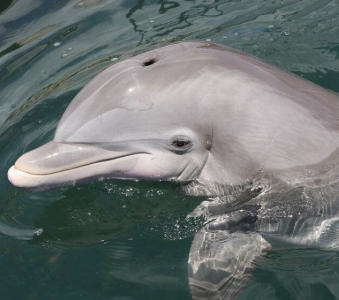 
Cetaceans are aquatic mammals belonging to the order Artiodactyla that includes whales, dolphins and porpoises. Key characteristics are their fully aquatic lifestyle, streamlined body shape, often large size, and exclusively carnivorous diet. They propel themselves through the water with the up-and-down movement of their tail, using their flipper-shaped forelimbs to maneuver. There are about 90 species of cetacean, in two different suborders:
 Cetaceans are mammals, so they breathe air, give birth to live young, produce milk, and have hair, all features of mammals.
Cetaceans are mammals, so they breathe air, give birth to live young, produce milk, and have hair, all features of mammals. The hair covering that is common to mammals is drastically reduced in cetaceans, likely because hair is a poor insulator when wet, and increases drag during swimming. Hairs on cetaceans are restricted to the head. The genitals and mammary glands are sunken into the body. The nostrils are usually located on top of the head above the eyes so that the rest of the body can remain submerged while surfacing for air. Cetaceans are well-known for their high intelligence, complex social behaviour, and the enormous size of some of the group's members. For example, the blue whale can reach a length of 30 metres and a weight of 173 tonnes, making it the largest animal to ever have existed.  Cetaceans have been extensively hunted for their meat, blubber and oil by commercial operations. Although the International Whaling Commission has agreed on putting a halt to commercial whaling, whale hunting is still going on
Cetaceans have been extensively hunted for their meat, blubber and oil by commercial operations. Although the International Whaling Commission has agreed on putting a halt to commercial whaling, whale hunting is still going on
Cetacean bodies are generally similar to those of fish. The body is wrapped in a thick layer of fat, known as blubber. This provides thermal insulation and gives cetaceans their smooth, streamlined body shape. In larger species, it can reach a thickness up to one-half metre. Most Cetaceans breathe while moving through the water, and spend only a short time at the surface, where they exhale in an explosive ventilation called a blow. The blow is expelled forcibly, and can be compared to a cough. Cetaceans use up to 80 percent of their lung volume in a single breath, in contrast to humans, who use only 20 percent. The blow is visible because of water condensation; blows of blue whales are frequently more than 6 metres high.  
|